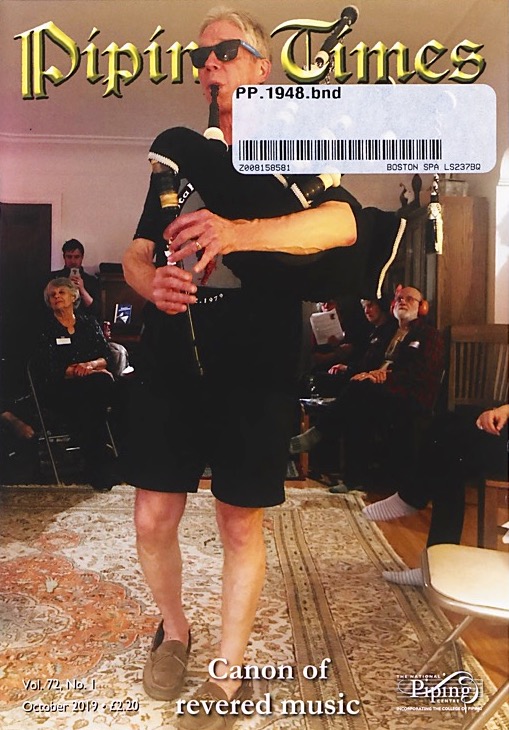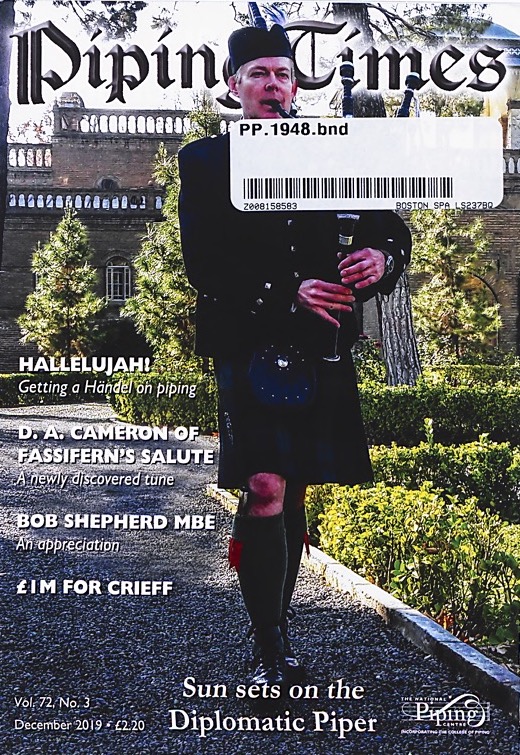|
|
10月号と12月号に、前編&後編
として掲載されてい
た興味深い記事が有りました。パッヘルベルの「カノン」と、ヘンデルの「ハレルヤ」といったバロック時代の超有名曲
を、ハイランド・パ
イプ用にアレンジした演奏が人気を博しているとの事。この記事ではそれぞれの曲について前編と後編に分け、パイプ・アレン
ジの要点について詳細に解説されています。前編は14ページの内9ページ、後編は7ページの内3ページを費やして全 部
のスコアが掲載されるという筆者の親切さに感じ入ります。
更に、情報として、The Simon Fraser University Pipe Band
を始めとする、複数の音楽家よるそれらの曲の演奏音源&映像についての情報も示されています。私は、複数のパイプがユニゾンで合奏する(+ドラム)という
形式の演奏には耐えられませんが、この場合は、複数のパイプが違ったパートを奏でる形式なので、少しは我慢できまし た(い
きなりオフにせず、半分ほど観れたという意味ですが…)。恐らく、この様な形式をお好きな方は多いと思います。
● Pachelbel's Canon
- Simon Fraser University Pipe Band at Royal Concert
Hall 2015
● Hallelujah -
Simon Fraser University Pipe Band at Royal Concert Hall
2015
他の音源&映像も含めてどうぞお楽しみ下さい。
これらの演奏を聴いても、やはり私自身はハイランド・パイプでピーブロック以外の曲を演奏する事には、イマイチ興
味が沸きません。…なので、記事の中でのアレンジの詳細な説明については省きますが、著者がバロック音楽とピーブロックの類似点について考察している箇所
については、多くの示唆に富んで
いて極めて興味深いと思います。以下に対訳で紹介します。お手数ですが、他の部分についてはオリジナル記事を参照願いま
す。
筆者の Jim Johnson
という人についての情報は見当たりません。恐らく、パイプのかおり第42話で
紹介した、Francis George Scott
と同様に、西洋クラッシック音楽に精通しつつ、ピーブロックにも詳しい人だと思われます。この様な人による幅広い視点からの解説は示唆に富んでいて、日
頃、狭い 世界に閉じ籠っている身にとっては、大変参考になります。
Pibroch
and Baroque music
by Jim Johnson
原
文
|
日
本語訳
|
| "Piping
Times" Vol.72/No.01 - 2019/10 |
| Johann Pachelbel composed
a large body of sacred and secular Baroque
music and is best known for his Canon
in D. Jim Johnson discusses
his own popular arrangement and discusses
the similarities between Baroque music and
ceol mor, |
Johann
Pachelbel は宗教的と世俗的なバロック音楽を大量に作曲
し、"Canon in D" が最もよく知られている。Jim Johnson
は人気を博している彼自身によるこの曲のアレンジについて述べ、バ ロック音楽と
Ceol Mor の類似点について考察している。 |
(former parts
omitted)
Firstly, though, I’ll discuss the links
between this type of music and ceol mor.
The golden period of pibroch composition,
the late 17th century, coincided with the
Baroque period; Johann Pachelbel and John
Dall MacKay (foremost pupil of Patrick Og
MacCrimmon) were contemporaries.
One obvious similarity between both
genres is that they that are slow and
repetitive (which some perceive as
boring/aggravating, others as
meditative/transcendental).
There’s more:
1. In Canon, the string
quartet functions somewhat like a bagpipe,
with the cello serving as the drones (bass
continuo) and the violins as the chanter
(treble melody).
2. Pachelbel explored many
variation forms and associated techniques,
which manifest themselves in his pieces.
3. The structure of Canon
resembles that of pibroch in that the tone
row of theme notes:
- gets repeated multiple times,
forming the piece’s organising
principle;
- is successively elaborated on and
transformed using multiple rhythmic
and melodic devices - in Canon
through 14 different variations, 13 of
which have a doubling, and in pibroch
through four-seven different
variations, many with a doubling,
(sometimes a trebling);
- is variably hidden vs. exposed. In
pibroch, in the ground and early
variations the tone row is hidden
within the busy melodic material. It
becomes the explicit ‘main event’ only
in the taorluath and crunluath
variations. In Canon, in the
violin (or bagpipe) line the tone row
is hidden within the busy melodic
material, but in the cello line, which
opens the piece, it’s exposed and
omnipresent. Thus, playing the violin
and cello lines together is like
playing the early and late variations
of a pibroch concurrently
4. Both genres reserve something
special for last. In Canon, there are the
so called ‘blue notes’ (jazzy C-naturals)
that appear in variations 11 and 12
whereas in pibroch there’s the crunluath
variation and, especially, the crunluath
a-mach.
5. Both pibroch and western
classical music grew out of hierarchical
societies.
The wealthy, privileged class could
support a cadre of elite professional
musicians, providing them with the time
and resources needed to create, refine,
and master the execution of elaborate art
music for their patrons’ amusement. This
is quite different from the simpler, foot
stomping ‘people’s music’ of the lower
class.
Wealthy patrons had time to savour
extended meditative compositions, and
desired such art to fill their leisure
hours, in addition to banquets, formal
gatherings, and militarly functions.
It seems to me there is at least one
point of difference: in Western Europe,
art music also had an ecclesiastical role,
with institutional patronage from the
church (e.g.,J. S. Bach). This does not
appear so with pibroch.
(later parts omitted)
|
(前略)
まず、この種の音楽と Ceol Mor
の関連について述べておこう。
ピーブロック作曲の黄金期である17世紀後半は、バロック時代と重なり、Johann Pachelbel
と John Dall MacKay(Patrick Og MacCrimmon
の一番弟子)は同時代に活躍していた。
この2つのジャンルの明らかな共通点は、ゆっくりとしていて繰り返しが多い、
ことであ る(これを、退屈/悩ましいと感じる人もいれば、瞑想/超
越的と感じる人 もいる)。
まだまだある。
1. カノンでは、弦楽四重奏はバグパイプのように機能し、チェロはド
ローン(通奏低 音)、ヴァイオリンはチャンター(高音旋律)の役割を果たす。
2. Pachelbel
は多くの変奏形式とそれに関連する技法を探求し、それが作品に現れている。
3. カノンの構造は、主題音の音列が何度も繰り返される点で、ピーブ
ロックと似てい る。
- 何度も繰り返され、曲の構成原理を形成する。
- カノンでは14種類の変奏(うち13種類は2倍音)、ピーブロックでは4〜7
種類の変奏、
多くは2倍音(時には3倍音)を通じて、複数のリズムや旋律の工夫によって次々と精緻に変形さ
れる。
- 隠されているもの、露出しているもの、様々である。ピーブロックでは、グラウ
ンドと初期の
バリエーションでは、音列は込み入ったメロディーの中に隠されている。それらは、
Taorluath と Crunluath
のバリエーションに於いてのみ、明確に「メインイベント」となる。カノンでは、ヴァイオリン(またはバグパイプ)のラインでは、音列は込み入ったメロ
ディーの中に隠されているが、曲の冒頭にあるチェロのラインでは、それが露出して
遍在してい
る。したがって、ヴァイオリンラインとチェロラインを一緒に演奏することは、ピーブロックの初
期バリエーションと後期バリエーションを同時に演奏するようなものである。
4. 両ジャンルとも、最後に何か特別なものを用意している。カノンで
は、いわゆる 「ブルーノート」(ジャズ的な
C-ナチュラル)が第11、12バリエーションに現れるが、ピーブロックでは
Crunluath、特に Crunluath a-mach が現れる。
5. ピーブロックも西洋のクラシック音楽も、階級社会から育ったもので
ある。
裕福な特権階級は、エリート専門音楽家の集団を支える事が可能で、彼らに、パトロンの娯
楽のための精
巧な芸術音楽を創作し、洗練し、その実行を習得するのに必要な時間と資源を提供する事が出来たのであ
る。
これは、より単純で、足を踏み鳴らすような、下層階級による「民衆の音楽」とは全く異な
るものであ る。
富裕層のパトロンたちは、瞑想的な曲をじっくりと味わう時間があり、宴会や公式の集ま
り、軍事的な行 事に加え、余暇を満たすためにこのような芸術を望んでいたのである。
しかし、少なくとも1つだけ違う点があるように思う。西ヨーロッパでは、芸術音楽も教会
的な役割を
担っており、教会から制度的なパトロンが与えられていた(J・S・バッハなど)。ピーブロックの場合は
そうではないようだ。
(後略)
|
"Piping
Times" Vol.72/No.03 - 2019/12
|
(former parts omitted)
“King of
Kings, Lord of Lords” section. (This
motif, incidentally, is vaguely
reminiscent of Donald Mor MacCrimmon's
iconic ‘run down’ to low G motif.)
(middle parts omitted)
Hallelujah vs. pibroch
Hallelujah exhibits certain
structural similarities to pibroch in
addition to the above-mentioned Donald Mor
‘run down’.
The opening section, “Hallelujah! For the
Lord God omnipotent reigneth”, could be
regarded as a ground equivalent, whereas
the subsequent sections (“And he shall
reign forever and ever” and “King of
Kings, Lord of Lords”) could be regarded
as variations on the ground.
Following these variations, to conclude,
“Hallelujah” returns to a
restatement of earlier material, analogous
to the pibroch convention of returning to
the ground after the crunluath (and, in
bygone days, perhaps repeatedly through
the tune). However, instead of returning
to the ground per se, for its concluding
statement, Hallelujah combines a
theme from the ground (the repeated “Hallelujahs”)
with the theme from the second variation (“And
He shall reign forever and ever”).
Pipers sometimes use an analogous
approach when concluding Desperate
Battle of the Birds by returning not
to the ground but to the (more dramatic)
first variation.
|
(前略)
"King of Kings, Lord of
Lords"の部分。(このモチーフは、Donald
Mor MacCrimmon の象徴的な Low G への
"run down" をどことなく彷彿とさせる)。
(中略)
ハレルヤとピーブロックの比較
ハレルヤは、前述の Donald
Mor の "run down"
に加え、ピーブロックと構造的に類似している部分がある。
冒頭の "Hallelujah! For the Lord God
omnipotent reigneth"
という冒頭部分はグラウンドと同じであり、続く部分("And he shall
reign forever and ever" と "King of Kings,
Lord of
Lords")はグラウンドのバリエーションと考えることができるだろう。
これらのバリエーションに続いて、締めの "Hallelujah"
は前の要素の再奏に戻るが、これはピーブロックの慣習である Crunluath
の後(昔は曲の中で何度も)グラウンドに戻ることと類似している。
しかし、ハレルヤでは、グラウンドそれ自体に戻るのではなく、グラウンドの主題(繰り返
される "Hallelujah")と、第2バリエーションの主題("And He
shall reign forever and
ever")とを組み合わせて、結びのパッセージとするのである。
パイパー達も時々、"Desperate Battle of
the Birds"
を締めくくるのに、グラウンドではなく、(よりドラマチックな)第1バリエーションに戻るという、似た様なアプローチを用いることがある。
|
- 冒頭でいきなり、Johann Pachelbel(1653〜
1706)と John(Iain) Dall MacKay(1656〜
1754)が同時代に活躍していた、といった指摘をされると、オッと思ってしまいます。確かに、当時のスコットラン
ド北部は海路で大陸と有機的に繋がっていて、決して文化的辺境の地などではありませんでした。音楽形式に関する相互
交流が有ったのも確かでしょう。それにしても、同時代性を引き合いに出す相手を Patrick Og(1645〜1730)の名を出しながら
も、彼自身では無くて、一番弟子たる Iain Dall の
名を出しているのも好ましい。つまり、この人はピーブロックの作曲家としてどちらが優れているかについて、良く判っ
ているのでしょう。
- 「ゆっくりとしていて繰り返しが多い事を、退屈/悩ましいと感じる人もいれば、瞑
想/超越的と感じる人もいる。」という解釈は実に的を得ています。問題なのは、前者が圧倒的多数である
事です。
- 音列の繰り返しの類似性についての解析も、言われて見れば納得。
- 「ピーブロックも西洋のクラシック音楽も、階級社会から育った」という見方もストンと腑に落ちます。富裕層のパ
トロンたちは、瞑想的な曲をじっくりと味わう時間が有った由。確かに…。
- ハレルヤの解説では Donald Mor の
"run down" まで引き合いに出してくるのも卓見ですね。
- しかし、最後の "Desperate Battle of the Birds"
の下りは?です。でも、私が知らないだけで、かの地にはその様な事をする人が居るのでしょう。興味深いですね。一度試してみましょう。
因みに、カノンについては、オリジナル(弦楽四重奏?)のアレンジバージョンだとしたら、私は断然こちらの方を好みます。《ハイランド・パイプの合奏》という演奏形態は、どう
しても、私の肌には合いません。
|

